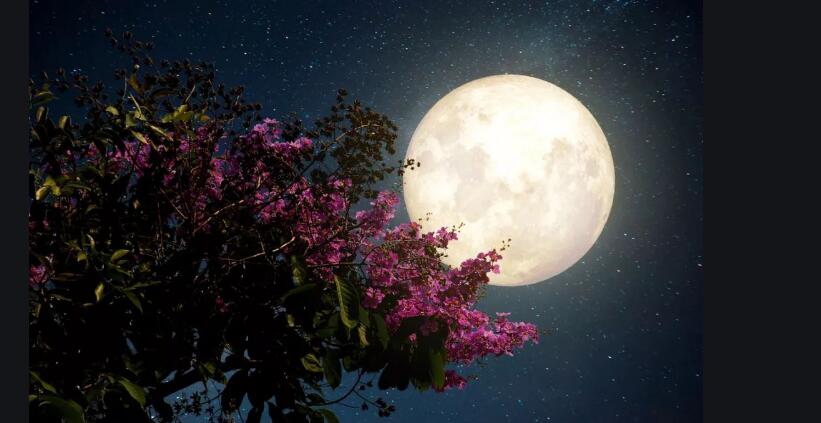As the fall season approaches and colder temperatures set in, there's a silver lining to look up to -- literally -- as the harvest moon makes its debut on September 20, bringing plenty of bright moonlight.
隨著秋天的臨近,天氣漸漸轉涼,夜空中的月亮也變得分外明亮-滿月將在9月20日首次出現(xiàn),為夜空帶來明亮的月光。

The full moon known as the harvest moon, as it traditionally gave farmers more time to harvest their summer-grown crops into the night, will make its appearance Monday night soon after sunset.
滿月也稱為獲月。根據(jù)傳統(tǒng),獲月會讓農(nóng)民有更多的時間在晚上收割在夏季所種下的莊稼。在周一的晚上,獲月在太陽落山后就會出現(xiàn)。
Appearing two days before the autumnal equinox this year, the full moon can first be seen at 7:55 p.m. ET, 17 minutes after sunset, according to NASA.
根據(jù)NASA,滿月比今年的秋分提早2天出現(xiàn)。最早看見滿月的時間為東部時間傍晚7點55份,即日落后17分鐘。
autumnal equinox:秋分
During the few days surrounding the harvest moon's appearance, the moonrise will occur within just 25 to 30 minutes across the northern United States and only 10 to 20 minutes in farther north Canada and Europe, according to NASA.
根據(jù)NASA,在滿月出現(xiàn)的前后幾天,月亮會在25到30分鐘內在美國北部升起,而在更遠的加拿大北部和歐洲,月亮的升起時間僅僅為10到20分鐘。
Typically, the moon rises around sunset and about 50 minutes later each day, according to EarthSky. But when a full moon occurs near an autumn equinox, like the harvest moon, the moon rises closer to the time of sunset, creating a dusk-till-dawn moonlight for several nights in a row.
根據(jù)EarthSky的介紹,一般來說,月亮會在日落后升起并在之后每天都會推遲大約50分鐘。但是,當滿月在秋分臨近時出現(xiàn),就像獲月,月亮升起的時間和日落時間更接近,這樣月光就會連續(xù)幾個晚上從黃昏持續(xù)到黎明。
This year's harvest moon will be the last of the summer season for those living in the Northern Hemisphere, while for those in the Southern Hemisphere it will be the fourth winter full moon, according to EarthSky.
根據(jù)EarthSky,對于生活在北半球的人們而言,今年的獲月將是夏季最后的一次滿月,而對于生活在南半球的人們而言,這將是第4個冬季滿月。
The harvest moon may seem bigger and brighter than other full moons, and that's because this moon is physically closer to the horizon. The location of this moon gives the illusion of largeness, despite not being any bigger than other full moons.
與其他滿月相比,獲月看上去似乎更大、更明亮。這是因為獲月實際上離地平線更近。月亮所在的位置給人一種大的感覺,盡管獲月其實并沒有比其他滿月大。
Another quirk to the harvest moon is its color -- it may look especially orange. That's also due to the fact that the harvest moon is closer to the horizon, which creates a greater thickness of Earth's atmosphere creating an orange hue, according to EarthSky.
根據(jù)EarthSky,獲月的另一個與眾不同之處是它的顏色-它看上去似乎是橙色的。這也是因為獲月離地平線更近,而這使地球大氣變得更厚并從而形成橙色的色調。
Quirk:怪異、怪癖
It's been a year of unusual celestial activity, with a rare third full moon, known as a Blue Moon, making an appearance in late August. Typically, it's more common for a season to have three full moons, however this year there will be four that occur in just one season alone, between the June solstice and September equinox.
今年是天文氣象非常不尋常的一年。今年出現(xiàn)了罕見的第三個滿月,也就是一個月中的第二個滿月,在8月末出現(xiàn)了。一般來說,一個季節(jié)有3次滿月是更加常見的。但是,在今年,僅在一個季節(jié),也就是6月夏至和9月秋分之間,就出現(xiàn)了4次滿月。
Blue Moon:一個月中第二個滿月
June solstice:6月夏至
Upcoming sky schedule
即將出現(xiàn)的天文現(xiàn)象時間表
Throughout the remainder of 2021, you might be able to catch these space and sky events depending on your location.
在2021年剩下的時間里,根據(jù)你所在的位置,你也許可以看到以下天文現(xiàn)象。
The full moons and their names, according to The Old Farmer's Almanac:
根據(jù)《老農(nóng)夫年鑒》(The Old Farmer's Almanac),各種滿月和它們的名字:
• September 20: harvest moon
9月20日:獲月
• October 20: hunter's moon
10月20日:狩獵月
• November 19: beaver moon
11月19日: 河貍月
• December 18: cold moon
12月18日:寒月
Meteor showers, according to EarthSky's 2021 meteor shower guide:
根據(jù)EarthySky 2021流星雨指南,流星雨出現(xiàn)的時間和名字:
• October 8: Draconids
10月8日:天龍座流星雨
• October 21: Orionids
10月21日:獵戶座流星雨
• November 4-5: South Taurids
11月4日-5日:金牛座南流星雨
• November 11-12: North Taurids
11月11日-12日:金牛座北流星雨
• November 17: Leonids
11月17日:獅子座流星雨
• December 13-14: Geminids
12月13日-14日:雙子座流星雨
• December 22: Ursids
12月22日:小熊座流星雨
When planets will be visible
可以看見行星的時間
Skywatchers will have multiple opportunities to spot the planets during certain mornings and evenings throughout the rest of 2021, according to the Farmer's Almanac planetary guide.
根據(jù)《老農(nóng)夫年鑒》中的行星指南,在2021年其余的時間里,天文觀測者在某些早晨和晚上還有很多發(fā)現(xiàn)行星的機會。
Seeing most of these -- except Neptune -- with the naked eye is possible, but binoculars or a telescope will provide the best view.
除了海王星,大部分行星可以用肉眼看到,但是雙筒望遠鏡或天文望遠鏡會帶來最佳的觀測景象。
Mercury will appear as a bright star in the morning sky from October 18 to November 1. It will shine in the night sky until September 21, and November 29 to December 31.
從10月18日到11月1日,水星,如同一顆明亮的星星,將在早晨的天空出現(xiàn)。它將在夜晚發(fā)光,一直到9月21日。在11月29日到12月31日之間,水星也會在夜晚發(fā)光。
Venus, our closest neighbor in the solar system, will appear in the western sky at dusk in the evenings through December 31. It's the second-brightest object in our sky, after the moon.
金星,在太陽系中與我們距離最近的行星,將會在12月31日的傍晚時分在西方的天空出現(xiàn)。金星是我們天空中繼太陽之后第二亮的行星。
Mars makes its reddish appearance in the morning sky between November 24 and December 31.
火星會在11月24日至12月31日之間在早晨的天空中露出有點發(fā)紅的“身影”。
Jupiter, the largest planet in our solar system, is the third-brightest object in our sky. Look for it in the evenings from now until December 31.
木星,太陽系中最大的行星,是天空中第三亮的星球。從現(xiàn)在開始直到12月31日,你可以在夜晚的天空中找到它。
Saturn's rings are only visible through a telescope, but the planet itself can still be seen with the naked eye in the evenings until December 31.
土星環(huán)只能通過天文望遠鏡看見,但是在12月31日之前,土星本身在晚上用肉眼還是可以看見的。
Saturn's rings:土星環(huán)
Binoculars or a telescope will help you spot the greenish glow of Uranus in the mornings through November 3 and in the evenings from November 4 to December 31. It will be at its brightest now until December 31.
雙筒望遠鏡或天文望遠鏡可以在11月3日的早晨和11月4日到12月31日的晚上幫助你發(fā)現(xiàn)天王星泛綠的光芒。在12月31日之前,天王星將呈現(xiàn)出最亮的光芒。
And our most distant neighbor in the solar system, Neptune, will be visible through a telescope in the evenings now until December 31. It will be at its brightest until November 8.
從現(xiàn)在直到12月31日的晚上,我們在太陽系中最遠的鄰居,也就是海王星,可以通過天文望遠鏡看到。海王星將呈現(xiàn)出最亮的光芒,直到11月8日。
來源:CNN 編輯&翻譯:Susan

